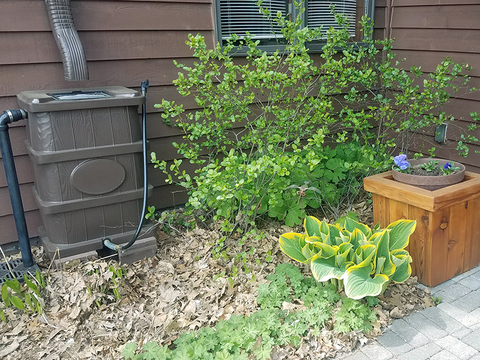Basic practices like watering in the morning and using mulches to keep the soil moist remain very important. Prioritizing what to water and reusing water safely will also help keep our landscapes healthy during extreme drought conditions.
An inch per week? Choosing what to water
Due to watering restrictions, fears of wells running dry, and simply wanting to conserve water, you may need to prioritize plants that need water the most.
The common saying that gardens need an inch of water per week is a good rule of thumb. But which plants actually need an inch per week and which plants can get by with less?
Here’s a quick guide to help you prioritize.
Water trees young and old - and shrubs too!
Mature trees need water yet they are some of the last plants we think about due to their size and the fact most leaves are well above our eye level.
Saturate the top 6-9 inches of soil with water to ensure those important feeder roots are well-watered. Most tree roots are located in the top 18-20 inches of soil and spread far beyond the tree's dripline (canopy edge). Small, effective feeder roots deliver much of the water and nutrients to the tree from the soil.
Read more about How to water established trees and shrubs.
Late summer and early fall can be a good time to plant new trees and shrubs. Again, be sure to water them. Visit How to water newly planted trees and shrubs for a formula for how much and how frequently to water. Note that daily watering of 1 to 1.5 gallons per inch of trunk diameter is required for the first two weeks after planting.
Evergreens need moist soil as we move into winter in order to reduce needles drying out. Think of each needle as a leaf. Deciduous trees and shrubs drop their leaves, but evergreens have to hang onto them through the winter and spring. Adequate water helps.
Focus on perennial flowers
Are you getting tired of watering your containers every day? Annual flowers are wrapping up their lifecycles for this year, so concentrate your water resources and effort on your perennials and bulbs that will be there next year.
September is a good month to plant spring bulbs like crocus, glory-of-the-snow (chionodoxa), daffodils, tulips and garlic. Be sure to plant in well-drained soil and water bulbs like you water your perennials.
Wondering if your perennials are dry? Get your hands in the soil and water if the top 6 inches of soil are dry.
As you start raking leaves, put them around your perennials, trees and shrubs as a mulch. Mulch holds in soil moisture while protecting roots, moderating soil temperatures, and overall reducing stress on landscape plants.
Don't overwater vegetable gardens
Often, due to concern over the drought, many gardeners may be overwatering their vegetables.
Some vegetables are hardier than others, and each vegetable has a critical period when consistent water is especially important for high-quality fruit, root, tuber, or bulb set. Usually, this period falls between flowering and fruit maturation.
- Pay extra attention to vegetables that are flowering and fruiting. These vegetables need consistent moisture. Watering a little bit every day or two is better than watering all at once.
- Storage crops reaching their time of harvest like potatoes and onions can be cut off from water at this point in the season if you plan to harvest in the next few weeks.
- Deep-rooted vegetables like tomatoes, squash and melons can pull moisture from deep in the soil, so they tend to be hardier than other vegetables.
- Sweet corn has very shallow roots and needs water more frequently.
- Cool-season crops like lettuce, broccoli and turnips need frequent water throughout the summer.
- Vegetables grown in pots need to be watered every day.
Reuse water
While most of our rain barrels have been pretty empty this summer, there are other ways to conserve and reuse water, such as using dishwater, water from coolers, and even capturing water from the shower in buckets to water your plants.
- Avoid reusing dishwater that contains a lot of soap as it can burn foliage, especially when applied in hot sun.
- Don’t reuse water that has had meat or bones cooked in it as the fat residue can attract animals.
- You can reuse water used to cook vegetables, just let it cool down first before applying.
Take advantage of your empty rain barrels to clean and disinfect them for next year. Read How to clean and care for a rain barrel.


